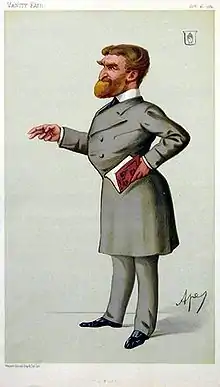Sir John Sinclair, Bt | |
|---|---|
 "A Poet", Sinclair as caricatured by Ape, October 1880 | |
| Member of Parliament for Caithness | |
| In office 1869–1885 | |
| Preceded by | George Traill |
| Succeeded by | Gavin Brown Clark |
| Personal details | |
| Born | John George Tollemache Sinclair 8 November 1825 Edinburgh, Scotland |
| Died | 30 September 1912 (aged 86) |
| Spouse |
Emma Standish
(m. 1853; div. 1878) |
| Relations | Sir William Talmash, 1st Baronet (grandfather) |
| Parent(s) | Sir George Sinclair, 2nd Baronet Lady Catherine Camilla Tollemache |
| Education | Cheam School |
| Alma mater | University of Durham |
Sir John George Tollemache Sinclair, 3rd Baronet (8 November 1825 – 30 September 1912) was a Scottish landowner and Liberal politician who sat in the House of Commons from 1869 to 1885.
Early life
Born in Edinburgh in 1825, he was the son of Sir George Sinclair, 2nd Baronet, and Lady Catherine Camilla Tollemache, daughter of William Talmash, Lord Huntingtower. He was a Page of Honour for Queen Adelaide.
Sinclair was educated at Cheam School and the University of Durham.[1]
Career
He served as a lieutenant in the Scots Fusilier Guards.[1] In 1861 he was made Vice-Lieutenant for Caithness.[2]
In 1868 he succeeded his father to the baronetcy. Sinclair was elected member of parliament for Caithness in 1869 and held the seat until 1885.[3] His majority of 13 over the Conservative candidate at the 1874 election is one of the smallest on record.[4] At the 1885 General election, his son Clarence succeeded him as Liberal candidate, but was defeated by Gavin Brown Clark, the Crofters' Party candidate.
Personal life
In 1853, Sinclair married Emma Standish, daughter of William Standish, Duxbury Park, Lancashire, and Cocken Hall, Durham.[5] Before their marriage was dissolved in 1878, the couple had two sons and two daughters:[6]
- Amy Camilla Sinclair (c. 1854–1925), who married John Henry Udny of Udny Castle, grandson of diplomat John Udny.[7][8]
- Nina Mary Adelaide Sinclair (1856–1924), who married Owen Lewis Cope Williams, son of Lt.-Col. Thomas Peers Williams.[9]
- Clarence Granville Sinclair (1858–1895), who married American heiress Mabel Sands, daughter of Mahlon Day Sands,[10] and half-sister of Ethel Sands.[11]
- George Felix Standish Sinclair JP (1861–1943), who married Margaret Sinclair, a daughter of Alexander Young Sinclair (son of Sir John Sinclair, 6th Baronet).
Sir John died on 30 September 1912. As he was predeceased by his eldest son Clarence, he was succeeded in the baronetcy by his grandson Archibald Henry Macdonald Sinclair, who was later created Viscount Thurso in 1952.[12]
Interests
Sinclair was the earliest born person to have made a gramophone disc recording. He made titles for Columbia, Gramophone and Typewriter Ltd. and Odeon, all in 1906.[13] He also commissioned a statue of Mary, Queen of Scots, at 143–144 Fleet Street, London.[14]
References
- 1 2 Debrett's House of Commons. London: Dean. 1867. p. 210. LCCN 07024615.
- ↑ "No. 22504". The London Gazette. 23 April 1861. pp. 1754–1754.
- ↑ Leigh Rayment's Historical List of MPs – Constituencies beginning with "C" (part 1)
- ↑ "Smallest majorities at Westminster". Archived from the original on 28 September 2007. Retrieved 1 January 2008.
- ↑ "Index entry". FreeBMD. ONS. Retrieved 19 February 2013.
- ↑ Fox-Davies, Arthur Charles (1910). Armorial Families: A Directory of Gentlemen of Coat-armour. T.C. & E.C. Jack. p. 1466. Retrieved 11 February 2022.
- ↑ Udny Castle, britainirelandcastles.com, retrieved 13 September 2013
- ↑ Historic Environment Scotland, "UDNY CASTLE (Category A Listed Building) (LB15922)", retrieved 9 January 2019
- ↑ "Index entry". FreeBMD. ONS. Retrieved 19 February 2013.
- ↑ "MAHLON SANDS'S DEATH.; A FATAL ACCIDENT IN LONDON, WHILE STARTING FOR A RIDE". The New York Times. 9 May 1888. p. 8. Retrieved 11 February 2022.
- ↑ Brack, Duncan (8 September 2015). British Liberal Leaders. Biteback Publishing. ISBN 978-1-84954-971-4. Retrieved 11 February 2022.
- ↑ "Data on family". Archived from the original on 21 September 2007.
- ↑ "A Gallery of Documentary and Speech 78s". Archived from the original on 27 September 2007. Retrieved 1 January 2008.
- ↑ "Statue commissioned by Sinclair". Retrieved 1 January 2008.